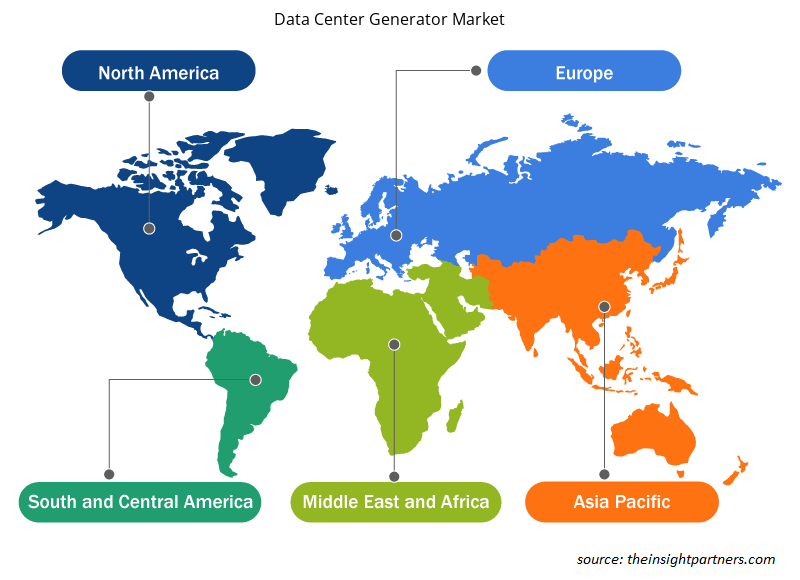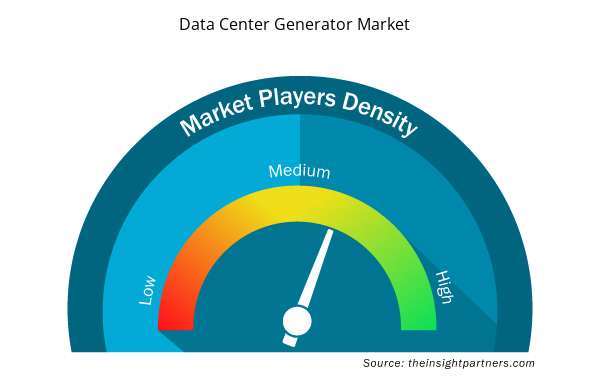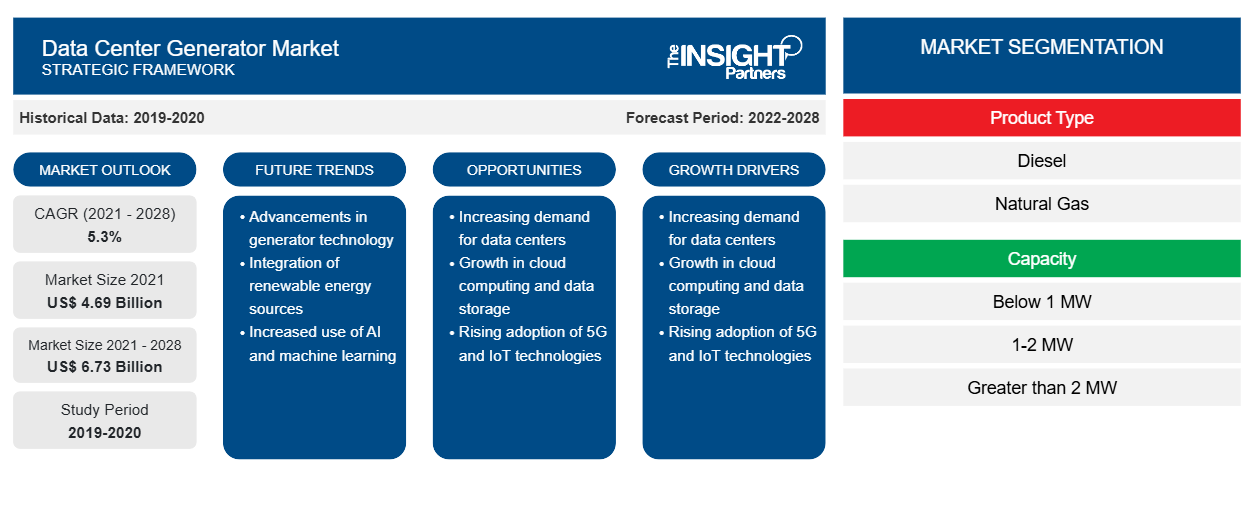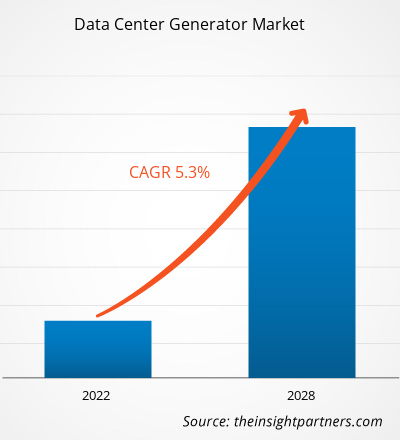[연구 보고서] 데이터 센터 발전기 시장은 2021년에 4,693.00백만 달러 규모였으며 2028년까지 6,729.53백만 달러에 도달할 것으로 예상되며 2021년부터 2028년까지 5.3%의 CAGR을 기록할 것으로 추산됩니다.
발전기는 정전 시 데이터 센터의 백업 전원 공급 저장소 역할을 합니다. 데이터 센터에서 정전이 발생하면 시스템을 재시작해야 할 수 있으며, 이로 인해 시스템 다운타임, 시작 문제 및 데이터 손실이 발생할 수 있습니다. 따라서 데이터 센터는 항상 발전기가 제공하는 백업 전원 공급으로 백업되어 이러한 이상 및 고장을 방지합니다. 이러한 이점이 데이터 센터 발전기 시장 성장을 주도하고 있습니다.
이러한 발전기는 작동하기 위해 기존 전원 공급 장치가 필요하지 않으며, 이는 시장의 중요한 추진 요소입니다. 또한, 저명한 제조업체는 변화하는 고객 수요에 대응하여 맞춤형 용량의 발전기를 제조합니다. 이러한 시스템은 데이터 센터의 전력 요구 사항에 따라 확장 및 축소할 수 있습니다. 이러한 적응성은 데이터 센터 발전기에 대한 수요를 증가시켜 시장 성장을 촉진할 가능성이 높습니다. 여러 클라우드 서비스 공급업체는 전 세계적으로 엣지 데이터 센터에 대한 수요가 증가함에 따라 생산량을 늘렸습니다. 예를 들어, Google은 2019년에 유럽에 데이터 센터를 확장하기 위해 33억 달러를 지출했습니다. 또한, 시장은 하이퍼스케일 시설의 개발 증가와 디젤 회전 무정전 전원 공급(DRUPS) 구현 증가로 인해 이익을 얻을 가능성이 높습니다.
귀하의 요구 사항에 맞게 이 보고서를 사용자 정의하세요
이 보고서의 일부 또는 국가 수준 분석, Excel 데이터 팩을 포함하여 모든 보고서에 대한 사용자 정의를 무료로 받을 수 있으며 신생 기업 및 대학을 위한 훌륭한 혜택과 할인 혜택을 이용할 수 있습니다.
- 이 보고서의 주요 시장 동향을 알아보세요.이 무료 샘플에는 시장 동향부터 추정 및 예측까지 다양한 데이터 분석이 포함됩니다.
데이터 센터 발전기 시장 통찰력
데이터 센터 수 증가
데이터 시대에 인터넷에 연결된 기기는 이미 약 70억 대이며, 그 숫자는 계속 늘어나고 있습니다. 그 중 다수는 기록, 라우팅, 저장, 평가 및 검색해야 하는 엄청난 양의 데이터를 생성합니다. 제조업체는 사물 인터넷(IoT)과 산업 4.0이 자리 잡으면서 운영의 효율성, 생산성, 보안 및 비용 효율성을 개선하기 위해 빅 데이터와 데이터 분석에 의존합니다. 반면, 사내 데이터 관리가 점점 더 복잡해지고, 시간이 많이 걸리고, 비용이 많이 듭니다. Cisco와 같은 대기업조차도 에너지와 인프라 비용을 절감하기 위해 자체 내부 데이터 센터의 일부를 폐쇄하는 것을 고려합니다.
연결된 기기의 보급률 증가와 인터넷에 대한 쉬운 접근성, 그리고 인터넷 서비스 비용의 감소가 전 세계적으로 데이터 스토리지에 대한 수요를 촉진하고 있습니다. 영화, 앱, 비디오, 소셜 미디어를 포함한 온라인 콘텐츠와 같은 빅데이터 분석 및 클라우드 기반 서비스에 대한 수요가 증가함에 따라 데이터 스토리지에 대한 필요성도 급증하고 있습니다. 따라서 클라우드 기반 기업은 데이터 센터에 IT 공간을 구축합니다. 여러 산업에서 클라우드 제공을 탐색하고 클라우드와 관련된 요구 사항을 지원하기 위해 데이터 센터 서비스의 이점을 발견하고 있습니다. 이러한 발전은 사물 인터넷(IoT) 사용 증가에 직접적인 영향을 미쳐 전 세계적으로 많은 수의 데이터 센터가 건설되고 있습니다. 예를 들어 Colt는 유럽 전역에 12개의 엣지 콜로케이션 센터를 매각한 후 유럽과 아시아 태평양에 하이퍼스케일 데이터 센터를 개발한다고 발표했습니다. 이 회사는 런던, 프랑크푸르트, 파리, 일본의 비공개 위치에 10개의 새로운 토지를 구매하여 약 100MW의 IT 전력을 생성할 수 있게 되었습니다. 따라서 데이터 센터의 수가 증가함에 따라 충분한 전력 공급을 확보하기 위한 데이터 센터 발전기의 필요성이 커지고 있으며, 이로 인해 데이터 센터 발전기 시장이 성장하고 있습니다.
제품 유형 기반 시장 통찰력
데이터 센터 발전기는 최근 몇 년 동안 전 세계적으로 수요가 증가하고 있습니다. 회사에서는 디젤, 천연 가스, 이중 연료의 세 가지 유형의 데이터 센터 발전기를 제공합니다. 2022년 1월, Cummins Power Generation은 중국 데이터 센터 산업에서 전력 솔루션에 대한 상을 수상했다고 발표했습니다. 이 회사는 디젤 데이터 센터 발전기를 제조합니다. 2021년 1월, TRG Datacenters는 텍사스 데이터 센터의 업그레이드를 발표했습니다. 이 회사는 전원 백업을 위한 이중 연료 옵션을 설치할 계획입니다.
용량 기반 시장 통찰력
용량 측면에서 데이터 센터 발전기 시장 규모는 1MW 미만, 1~2MW, 2MW 초과로 세분화됩니다. 1MW 미만은 데이터 센터 발전기에서 가장 두드러진 용량입니다. 10MW 이상 용량의 시설은 2MW 이상의 발전기를 채택하고 있습니다. 1MW 미만의 전력 용량의 발전기는 일반적으로 모듈식 데이터 센터 배포에 채택됩니다. 1MW 미만의 전력 용량의 발전기를 채택하면 데이터 센터 배포가 늘어날 것으로 예상됩니다. 개발 도상국의 소규모 데이터 센터 운영자가 비용이 적게 들기 때문에 채택하고 있습니다. 신흥 경제권에서 하이퍼 스케일 시설 제조가 증가함에 따라 향후 몇 년 동안 용량이 낮은 발전기에 대한 의존도가 낮아질 것입니다.
데이터 센터 발전기 시장 참여자들은 시장에서의 입지를 유지하기 위해 합병, 인수, 시장 이니셔티브와 같은 전략을 채택합니다. 주요 데이터 센터 발전기 시장 참여자들의 몇 가지 개발은 다음과 같습니다.
- ABB LTD는 새로운 샤프트 발전기 기술을 도입했습니다. 이 새로운 발전기는 벌크선과 컨테이너선 등 많은 선박에 유연성과 설치 용이성을 제공합니다. AMZ 1400 영구 자석 샤프트 발전기는 컨버터 제어에 최적화되어 있으며 유도보다 더 나은 효율성을 제공합니다.
- Caterpillar, Microsoft 데이터 센터에서 백업 전원에 수소 연료 전지 기술을 사용하는 시범 프로젝트 시작. 이 프로젝트를 통해 Caterpillar는 업계 리더와 협력하여 상업적으로 실행 가능한 전력 솔루션을 향한 큰 발걸음을 내딛고, 고객이 운영을 보다 지속 가능하게 만들 수 있도록 지원합니다.
데이터 센터 발전기 시장 지역 통찰력
Insight Partners의 분석가들은 예측 기간 동안 데이터 센터 발전기 시장에 영향을 미치는 지역적 추세와 요인을 철저히 설명했습니다. 이 섹션에서는 북미, 유럽, 아시아 태평양, 중동 및 아프리카, 남미 및 중미의 데이터 센터 발전기 시장 세그먼트와 지리에 대해서도 설명합니다.

- 데이터 센터 발전기 시장에 대한 지역별 데이터를 얻으세요
데이터 센터 발전기 시장 보고서 범위
| 보고서 속성 | 세부 |
|---|---|
| 2021년 시장 규모 | 46억 9천만 달러 |
| 2028년까지 시장 규모 | 67억 3천만 달러 |
| 글로벌 CAGR (2021-2028) | 5.3% |
| 역사적 데이터 | 2019-2020 |
| 예측 기간 | 2022-2028 |
| 다루는 세그먼트 | 제품 유형별
|
| 포함된 지역 및 국가 | 북아메리카
|
| 시장 선도 기업 및 주요 회사 프로필 |
|
데이터 센터 발전기 시장 참여자 밀도: 비즈니스 역학에 미치는 영향 이해
데이터 센터 발전기 시장은 소비자 선호도의 변화, 기술 발전, 제품의 이점에 대한 인식 증가와 같은 요인으로 인해 최종 사용자 수요가 증가함에 따라 빠르게 성장하고 있습니다. 수요가 증가함에 따라 기업은 제품을 확장하고, 소비자의 요구를 충족하기 위해 혁신하고, 새로운 트렌드를 활용하여 시장 성장을 더욱 촉진하고 있습니다.
시장 참여자 밀도는 특정 시장이나 산업 내에서 운영되는 회사나 기업의 분포를 말합니다. 주어진 시장 공간에 얼마나 많은 경쟁자(시장 참여자)가 존재하는지 그 규모나 전체 시장 가치에 비해 나타냅니다.
데이터 센터 발전기 시장에서 운영되는 주요 회사는 다음과 같습니다.
- 씨줄
- 아틀라스 콥코 AB
- 무한 궤도
- 커민스 주식회사
- 도이츠 AG
면책 조항 : 위에 나열된 회사는 어떤 특별한 순서에 따라 순위가 매겨지지 않았습니다.

- 데이터 센터 발전기 시장 주요 주요 업체 개요를 알아보세요
글로벌 데이터 센터 발전기 시장은 제품 유형, 용량 및 계층에 따라 세분화됩니다. 제품 유형에 따라 데이터 센터 발전기 시장은 디젤, 천연 가스 및 기타로 세분화됩니다. 용량 측면에서 데이터 센터 발전기 시장은 1MW 미만, 1~2MW 및 2MW 초과로 세분화됩니다. 또한 계층에 따라 데이터 센터 발전기 시장은 1&2계층, 3계층 및 4계층으로 세분화됩니다.
ABB; Atlas Copco AB; Caterpillar; Cummins Inc.; DEUTZ AG; Generac Power Systems, Inc.; HITEC Power Protection; Kirloskar; Kohler Co.; 및 MITSUBISHI MOTORS CORPORATION은 연구 조사에 고려된 주요 데이터 센터 발전기 시장 참여자입니다. 또한, 이 연구 보고서에서는 글로벌 데이터 센터 발전기 시장 규모와 생태계에 대한 전체적인 관점을 얻기 위해 다른 여러 주요 데이터 센터 발전기 시장 참여자를 연구하고 분석했습니다.
- 역사적 분석(2년), 기준 연도, CAGR을 포함한 예측(7년)
- PEST 및 SWOT 분석
- 시장 규모 가치/양 - 글로벌, 지역, 국가
- 산업 및 경쟁 환경
- Excel 데이터 세트


- Smart Water Metering Market
- 3D Mapping and Modelling Market
- Artwork Management Software Market
- Aesthetic Medical Devices Market
- Industrial Inkjet Printers Market
- Broth Market
- Small Molecule Drug Discovery Market
- Pharmacovigilance and Drug Safety Software Market
- Truck Refrigeration Market
- Data Annotation Tools Market

Report Coverage
Revenue forecast, Company Analysis, Industry landscape, Growth factors, and Trends

Segment Covered
This text is related
to segments covered.

Regional Scope
North America, Europe, Asia Pacific, Middle East & Africa, South & Central America

Country Scope
This text is related
to country scope.
자주 묻는 질문
The rising inclination towards renewables are environmental sustainability and energy savings is positively impacting the data center generator market. When rising and unpredictable energy costs and levies linked with pending carbon emission regulations are considered, it is easy to see why operators are becoming more interested in renewables' role in lowering and stabilizing energy costs. Google's hyper-scale data centers have been pioneers in renewable energy programs, researching their inherent financial, environmental, and social value. Google chooses locations for its data centers based on various considerations, including the availability of reliable service and the opportunity for renewable energy. Thus, these initiatives are further expected to contribute to the growth of the data center generator market over the forecast period.
The diesel segment led the data center generator market with a market share of 69.7% in 2020. It is expected to account for 68.7% of the total market in 2028.
Most data centers maintain enough fuel on hand to run the generator for 24-48 hours. To preserve sensitive data, data centers require dependable backup power. Thus, the global data center generator market is primarily driven by the increase in number of data centers and in backup power supply requirements in data centers.
North America dominated the data center generator market in 2020 with a share of 37.25%; it would continue to dominate the market during the forecast period and account for 31.67% share by 2028. Europe is the second-largest contributor to the global data center generator market, followed by Asia Pacific.
ABB; Atlas Copco AB; Caterpillar; Cummins Inc.; DEUTZ AG; Generac Power Systems, Inc.; HITEC Power Protection; Kirloskar; Kohler Co.; and MITSUBISHI MOTORS CORPORATION.
The less than 1MW segment led the data center generator market with a market share of 44.4% in 2020. It is expected to account for 46.1% of the total market in 2028.
Trends and growth analysis reports related to Energy and Power : READ MORE..
The List of Companies - Data Center Generator Market
- ABB
- Atlas Copco AB
- Caterpillar
- Cummins Inc.
- DEUTZ AG
- Generac Power Systems, Inc.
- HITEC Power Protection
- Kirloskar
- Kohler Co.
- MITSUBISHI MOTORS CORPORATION
The Insight Partners performs research in 4 major stages: Data Collection & Secondary Research, Primary Research, Data Analysis and Data Triangulation & Final Review.
- Data Collection and Secondary Research:
As a market research and consulting firm operating from a decade, we have published and advised several client across the globe. First step for any study will start with an assessment of currently available data and insights from existing reports. Further, historical and current market information is collected from Investor Presentations, Annual Reports, SEC Filings, etc., and other information related to company’s performance and market positioning are gathered from Paid Databases (Factiva, Hoovers, and Reuters) and various other publications available in public domain.
Several associations trade associates, technical forums, institutes, societies and organization are accessed to gain technical as well as market related insights through their publications such as research papers, blogs and press releases related to the studies are referred to get cues about the market. Further, white papers, journals, magazines, and other news articles published in last 3 years are scrutinized and analyzed to understand the current market trends.
- Primary Research:
The primarily interview analysis comprise of data obtained from industry participants interview and answers to survey questions gathered by in-house primary team.
For primary research, interviews are conducted with industry experts/CEOs/Marketing Managers/VPs/Subject Matter Experts from both demand and supply side to get a 360-degree view of the market. The primary team conducts several interviews based on the complexity of the markets to understand the various market trends and dynamics which makes research more credible and precise.
A typical research interview fulfils the following functions:
- Provides first-hand information on the market size, market trends, growth trends, competitive landscape, and outlook
- Validates and strengthens in-house secondary research findings
- Develops the analysis team’s expertise and market understanding
Primary research involves email interactions and telephone interviews for each market, category, segment, and sub-segment across geographies. The participants who typically take part in such a process include, but are not limited to:
- Industry participants: VPs, business development managers, market intelligence managers and national sales managers
- Outside experts: Valuation experts, research analysts and key opinion leaders specializing in the electronics and semiconductor industry.
Below is the breakup of our primary respondents by company, designation, and region:

Once we receive the confirmation from primary research sources or primary respondents, we finalize the base year market estimation and forecast the data as per the macroeconomic and microeconomic factors assessed during data collection.
- Data Analysis:
Once data is validated through both secondary as well as primary respondents, we finalize the market estimations by hypothesis formulation and factor analysis at regional and country level.
- Macro-Economic Factor Analysis:
We analyse macroeconomic indicators such the gross domestic product (GDP), increase in the demand for goods and services across industries, technological advancement, regional economic growth, governmental policies, the influence of COVID-19, PEST analysis, and other aspects. This analysis aids in setting benchmarks for various nations/regions and approximating market splits. Additionally, the general trend of the aforementioned components aid in determining the market's development possibilities.
- Country Level Data:
Various factors that are especially aligned to the country are taken into account to determine the market size for a certain area and country, including the presence of vendors, such as headquarters and offices, the country's GDP, demand patterns, and industry growth. To comprehend the market dynamics for the nation, a number of growth variables, inhibitors, application areas, and current market trends are researched. The aforementioned elements aid in determining the country's overall market's growth potential.
- Company Profile:
The “Table of Contents” is formulated by listing and analyzing more than 25 - 30 companies operating in the market ecosystem across geographies. However, we profile only 10 companies as a standard practice in our syndicate reports. These 10 companies comprise leading, emerging, and regional players. Nonetheless, our analysis is not restricted to the 10 listed companies, we also analyze other companies present in the market to develop a holistic view and understand the prevailing trends. The “Company Profiles” section in the report covers key facts, business description, products & services, financial information, SWOT analysis, and key developments. The financial information presented is extracted from the annual reports and official documents of the publicly listed companies. Upon collecting the information for the sections of respective companies, we verify them via various primary sources and then compile the data in respective company profiles. The company level information helps us in deriving the base number as well as in forecasting the market size.
- Developing Base Number:
Aggregation of sales statistics (2020-2022) and macro-economic factor, and other secondary and primary research insights are utilized to arrive at base number and related market shares for 2022. The data gaps are identified in this step and relevant market data is analyzed, collected from paid primary interviews or databases. On finalizing the base year market size, forecasts are developed on the basis of macro-economic, industry and market growth factors and company level analysis.
- Data Triangulation and Final Review:
The market findings and base year market size calculations are validated from supply as well as demand side. Demand side validations are based on macro-economic factor analysis and benchmarks for respective regions and countries. In case of supply side validations, revenues of major companies are estimated (in case not available) based on industry benchmark, approximate number of employees, product portfolio, and primary interviews revenues are gathered. Further revenue from target product/service segment is assessed to avoid overshooting of market statistics. In case of heavy deviations between supply and demand side values, all thes steps are repeated to achieve synchronization.
We follow an iterative model, wherein we share our research findings with Subject Matter Experts (SME’s) and Key Opinion Leaders (KOLs) until consensus view of the market is not formulated – this model negates any drastic deviation in the opinions of experts. Only validated and universally acceptable research findings are quoted in our reports.
We have important check points that we use to validate our research findings – which we call – data triangulation, where we validate the information, we generate from secondary sources with primary interviews and then we re-validate with our internal data bases and Subject matter experts. This comprehensive model enables us to deliver high quality, reliable data in shortest possible time.


 이 보고서에 대한 무료 샘플을 받으세요
이 보고서에 대한 무료 샘플을 받으세요